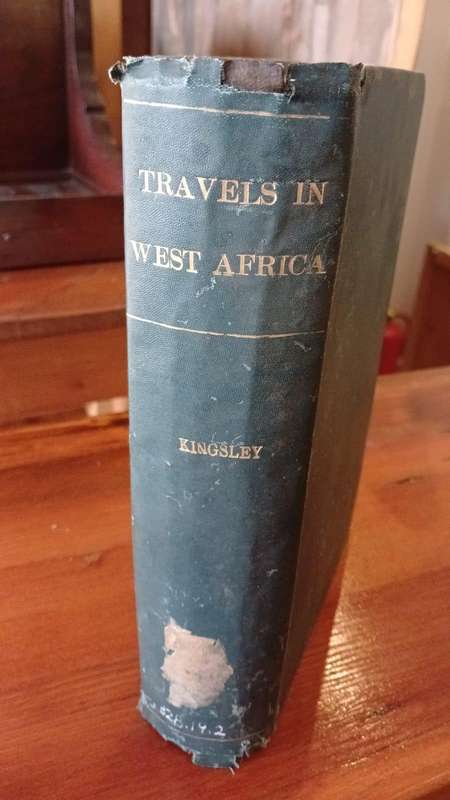Macmillan publishers, 1897, hardcover, illustrated, map, index, 743 pages, ex- central refernce library book with usual stamps, some slight loss to upper/lower margins of spine, otherwise condition:very good.
With sixteen halftones, two lithographed fish plates and many textual illustrations. Publisher's cloth, gilt lettering on spine, First edition of Kingsley's first adventurous journey.Mary Kingsley (1862-1900) spent her first thirty years at home caring for her parents. She read most of her father's library and inherited his passion for travel. After the parent's death, she travelled twice to West Africa to study tribal religions and collect natural history specimens. The first journey in 1893 took her to the Fjort tribe on the Congo, then north through the Congo Free State to French territory and to the British Old Calabar. She returned to England with a valuable natural history collection. Her two travel accounts, written with a great sense of humour, became instant bestsellers. In 1900 she died at Simonstown where she had volunteered for nursing service in the South African War.
Mary Kingsley was an English ethnographer, writer and explorer who made numerous travels through West Africa and wrote several books on her experiences there. Historians have credited Kingsley's work with helping to shape Western perceptions of the culture of Africa and colonialism.
Mary landed in Sierra Leone on 17 August 1893 and from there travelled further to Luanda in Angola. She lived with local people, who taught her necessary surviving-skills for living in the wilderness, acted as luggage porters and guides for her travels, and gave her advice. She often went into dangerous areas alone. Her training as a nurse at the de:Kaiserswerther Diakonie had prepared her for slight injuries and jungle maladies that she would later encounter. Kingsley returned to England in December 1893.
She returned to Africa again on 23 December 1894 with more support and supplies from England, as well as increased self-assurance in her work. She longed to study "cannibal" people and their traditional religious practices, commonly referred to as "fetish" during the Victorian Era. In April, she became acquainted with Scottish missionary Mary Slessor, another European woman living among native African populations with little company and no husband. It was during her meeting with Slessor that Kingsley first became aware of the custom of twin killing, a custom which Slessor was determined to stop. The native people believed that one of the twins was the offspring of the devil who had secretly mated with the mother and since the innocent child was impossible to distinguish, both were killed and the mother was often killed as well for attracting the devil to impregnate her. Kingsley arrived at Slessor's residence shortly after she had taken in a recent mother of twins and her surviving child.
Later in Gabon, Kingsley canoed up the Ogooué River, where she collected specimens of fish previously unknown to western science, three of which were later named after her. After meeting the Fang people and travelling through uncharted Fang territory, she daringly climbed the 4,040 metres Mount Cameroon by a route not previously attempted by any other European.
.
An important book.

